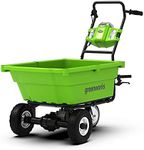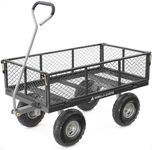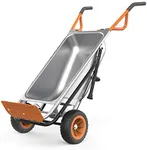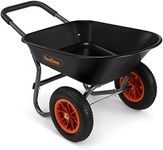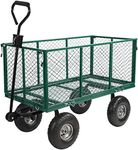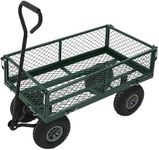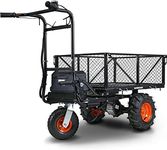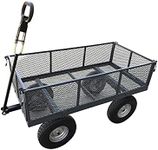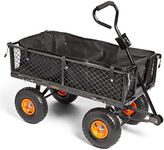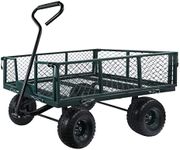Buying Guide for the Best Garden Carts
Choosing the right garden cart can make your gardening tasks much easier and more efficient. A garden cart is a versatile tool that helps you transport soil, plants, tools, and other materials around your garden with ease. When selecting a garden cart, consider the size of your garden, the types of materials you will be transporting, and your own physical capabilities. The right garden cart should be durable, easy to maneuver, and suitable for the specific tasks you have in mind.CapacityCapacity refers to the amount of weight or volume a garden cart can carry. This is important because it determines how much you can transport in one trip. Garden carts come in various capacities, typically measured in cubic feet or pounds. Smaller carts, with capacities around 3-5 cubic feet, are suitable for light tasks like moving small plants or tools. Medium-sized carts, with capacities of 6-10 cubic feet, are ideal for general gardening tasks. Larger carts, with capacities over 10 cubic feet, are best for heavy-duty tasks like moving large amounts of soil or mulch. Choose a capacity that matches the scale of your gardening activities.
MaterialThe material of a garden cart affects its durability, weight, and ease of maintenance. Common materials include plastic, metal, and wood. Plastic carts are lightweight and resistant to rust, making them easy to handle and maintain, but they may not be as durable for heavy loads. Metal carts, often made of steel, are very durable and can handle heavy loads, but they can be prone to rust if not properly maintained. Wooden carts offer a classic look and are quite sturdy, but they require more maintenance to prevent weather damage. Consider the typical weather conditions in your area and the types of materials you will be transporting when choosing the material of your cart.
WheelsWheels are crucial for the maneuverability of a garden cart. They come in different sizes and materials, affecting how easily the cart can be moved over various terrains. Smaller wheels are suitable for smooth, flat surfaces, while larger wheels are better for rough or uneven terrain. Pneumatic (air-filled) wheels provide a smoother ride and better shock absorption, making them ideal for bumpy gardens. Solid rubber or plastic wheels are maintenance-free and work well on even surfaces. Consider the terrain of your garden and choose wheels that will provide the best mobility for your needs.
Handle DesignThe handle design of a garden cart affects how comfortable and easy it is to pull or push. Handles can be straight, looped, or ergonomic. Straight handles are simple and effective for pulling, while looped handles offer more control and are easier to grip with both hands. Ergonomic handles are designed to reduce strain and provide comfort during use, which is beneficial if you have a large garden or plan to use the cart frequently. Consider your physical strength and comfort preferences when selecting a handle design.
Dump FeatureSome garden carts come with a dump feature, allowing you to easily tip the cart and unload its contents. This is particularly useful for transporting loose materials like soil, mulch, or gravel. Carts with a dump feature often have a pivot point that makes it easier to tilt the cart without lifting the entire load. If you frequently move bulk materials, a cart with a dump feature can save you time and effort. Consider whether this feature aligns with the types of tasks you perform in your garden.
